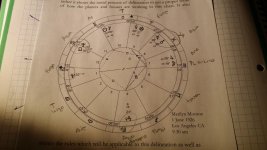Hi.
I'm trying to give a value to the accidental dignities of the marilyn monroe natal chart, that is provided by example to study on the Rod Suskin book.
You have to tell which planets are direct, and I would say all except the moon, soon, and saturn.
But in the example, mars is not given the direct calification, neither the retrograde (because is not retrograde)
I put a picture of thr natal.chart so you dont have to look for it
Am I missing something?
Only Saturn is Retrograde - the giveaway is that Saturn is marked Rx, the abbreviation for Retrograde.
Use the Rx marker as the indication that a planet is Retrograde. Without it they are Direct. That really is enough to answer your question. However, given that you mention the accidental dignities a knowledge of the phases of the planet relative to the Sun will help you on such issues as Oriental/Occidental and Speed.
Firstly The Sun and Moon can never be Retrograde, which technically is a product of the relative speeds and positions of the other planets to Earth, in its orbit around the Sun. As the Moon is a satellite of Earth, it cannot become Retrograde accompanying it in its orbit. The Sun doesn't move relative to the other planets (or at least not significantly in this respect).
For the superior planets, that's Mars outwards, you should be aware of their cycle with the Sun. The Sun is faster (always) than they are. So starting with the Conjunction with the Sun, the Sun will move ahead in the Zodiac compared to the superior planet. Technically they are oriental at this stage and remain so through to the opposition. This means that they are visible before sunrise (apart from the outers).
Their first two major aspects, the sextile and square from the Sun are with the planet direct. Technically these are an aspect to the right from the Sun or against the order of Signs (backwards in the Zodiac). Between that square and the first trine (also backwards in the Zodiac) all but Mars turn Retrograde - between about 99 degrees for Pluto and 117 for Jupiter - the further out the 'sooner' the planet turns Retrograde.
For Mars, that station Retrograde occurs after the first trine - around 138 degrees. All superior planets are Retrograde at the opposition. All but Mars will turn Direct just before the second Trine (now in the order of signs), Mars turns Direct about 15-20 days after that second trine. The planets are now occidental, they are seen after sunset.
So, all squares and sextiles between the outers and the Sun are Direct. Trines are the things to look for. If the superior is around its first or second trine to the Sun then it is either slowing down to station Retrograde (first trine) is Retrograde or is about to station Direct (second trine). Although computer programs mark the planets as Rx when they are actually retrograde, they don't give any direct indication of how near they are to a station. Knowing that it occurs arould the trines should get you to check speed.
For the inferiors, Mercury and Venus, the situation is rather more complicated because they never even make a sextile to the Sun. Use their separation in degress from the Sun as a guide. Mercury's maximum elongation from the Sun is 27 degrees (48 for Venus). There are two conjunctions with the Sun for each of them.
The first is with the planet Direct and is called the superior conjunction, Mercury and Venus are on the other side of the Sun to Earth and moving forwards. As both are faster than the Sun, they then go ahead in the Zodiac. Around their maximum elongation they will slow down and the Sun will begin to catch them up a couple of days later, they station Retrograde.
During this phase they are Evening Stars, seen in the evening because the Sun has already set and being further ahead in the Zodiac. They then move in to Retrograde phase and move back quickly to the Sun because they are moving backwards in the Zodiac (from and Earth perspective) and the Sun is moving forwards. There is then a second conjunction called the inferior conjunction. This occurs when they are on the same side of the Sun as Earth. For Venus, this is the conjunction that very occasionally produces Venus transits of the Sun.
They continue to move retrograde till they are around the same elongation from the Sun as their Station Retrograde. This time they station Direct just before they reach that maximum elongation but their slow speed compared to the Sun means that the gap still widens for a couple of days. During this phase they are a Morning star , rising before the Sun(oriental) because they are earlier in the Zodiac. They then start to catch the Sun up, returning to the superior conjunction.
For chart inspection, their Retrograde status is easy to see from Rx marked by their glyph. However inspection of their separation by degree from the Sun can give you an indication of coming Stations and therefore whether the planet is fast or slow.
So now you should be able to identify not only Retrograde planets but oriental and occidental ones, plus a good guess at fast or slow planets.
Edited to add:
Notice that the superior planets are oriental at the start of their cycle with the Sun. The inferiors are occidental at the start of their cycle. This is why being oriental is an accidental dignity for Mars, Jupiter and Saturn and being occidental is an accidental dignity for Mercury and Venus. Beginnings are better than endings, generally speaking.


